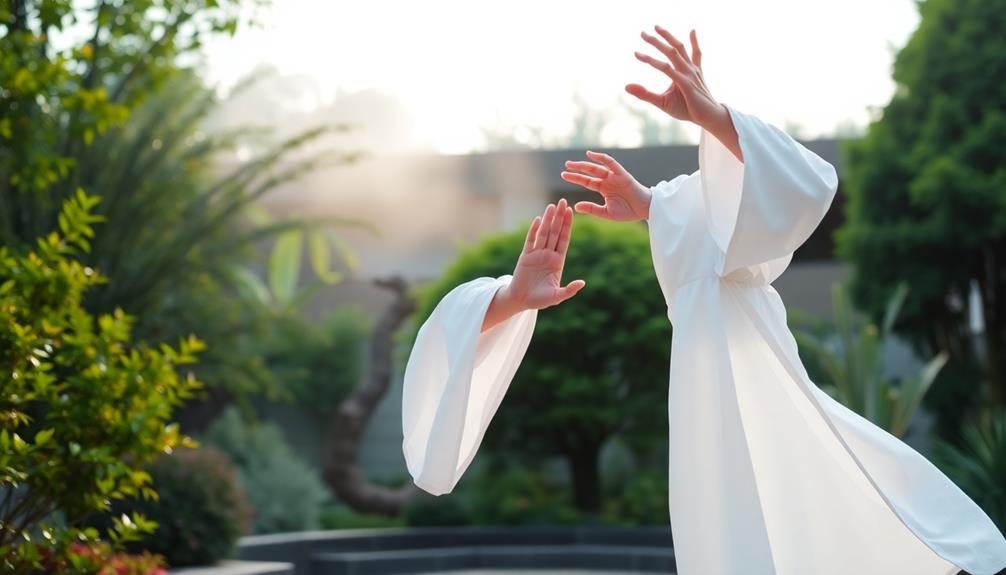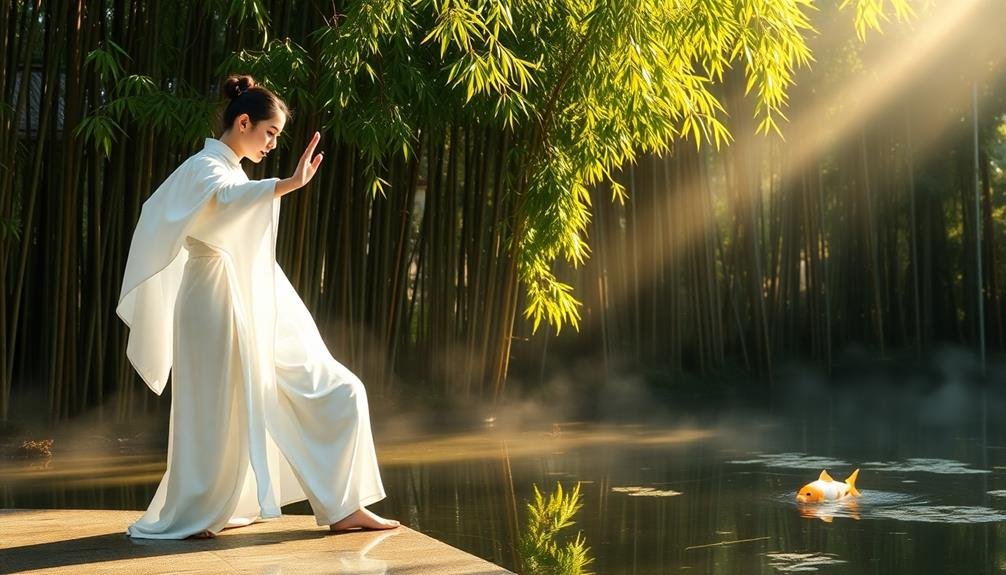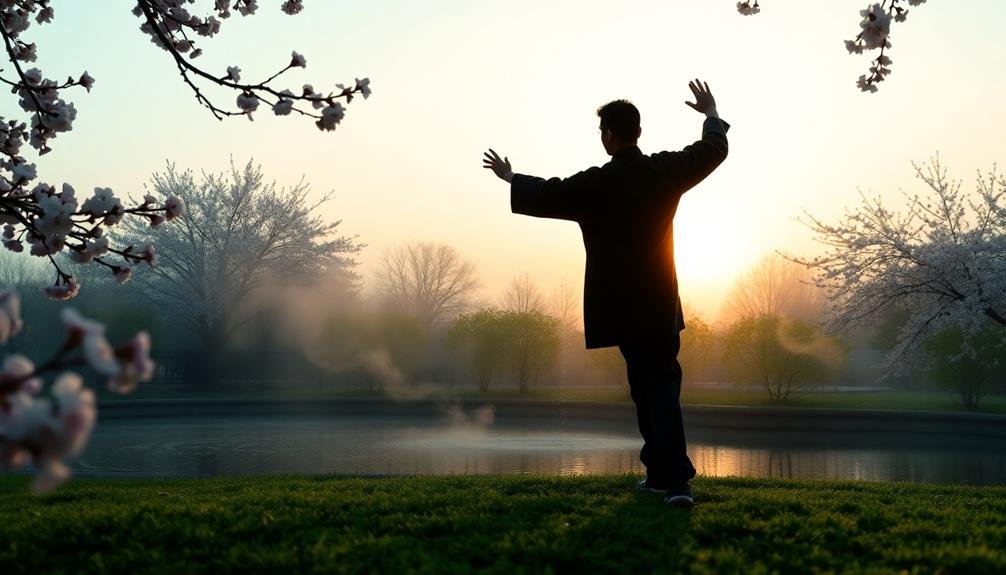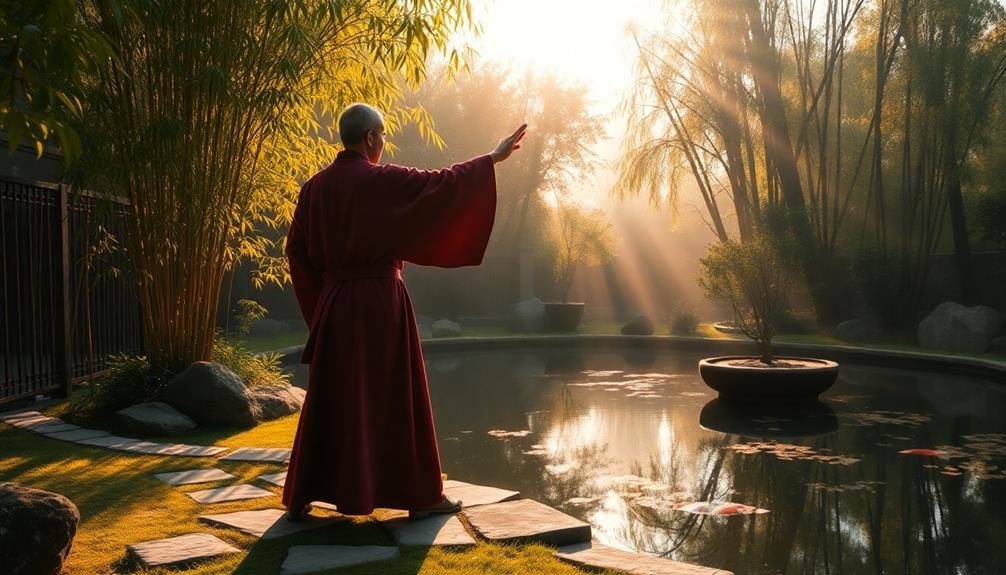Discover the power of Tai Chi and Qigong to conquer anxiety with these five tips. Start with mindful breathing techniques, focusing on deep, controlled breaths to center your mind. Incorporate gentle movements like "Pushing Hands" and "Cloud Hands" to release tension and promote relaxation. Cultivate inner balance by harmonizing your thoughts, emotions, and physical sensations. Ground yourself in nature, connecting with the earth through barefoot exercises and sensory engagement. Establish a daily practice ritual, even if it's just for a few minutes each morning. These ancient practices offer a holistic approach to stress relief, with benefits that extend far beyond your practice sessions.
Mindful Breathing Techniques

Focusing on your breath, mindful breathing techniques form the foundation of both Tai Chi and Qigong practices. These ancient Chinese arts emphasize controlled, deep breathing to reduce stress and promote relaxation.
To begin, find a comfortable seated position and close your eyes. Inhale slowly through your nose, allowing your belly to expand, then exhale through your mouth, letting your abdomen contract.
As you practice, focus on the sensation of air entering and leaving your body. Count your breaths to maintain concentration, starting with a cycle of four: inhale for four counts, hold for four, exhale for four, and pause for four. Gradually increase the count as you become more comfortable.
Incorporate visualization by imagining stress leaving your body with each exhale and calmness entering with each inhale.
Another technique is the "ocean breath," where you slightly constrict your throat to create a soft, rushing sound as you breathe. This auditory focus can help quiet your mind and deepen your relaxation.
Gentle Movement for Stress Release
Three key movements in Tai Chi and Qigong can help release stress and tension from your body.
First, try the "Pushing Hands" movement. Stand with your feet shoulder-width apart, bend your knees slightly, and extend your arms forward. Gently push your palms outward as if pressing against an invisible wall. This movement helps release tension in your shoulders and upper back.
Next, practice the "Cloud Hands" technique. Stand with your feet hip-width apart and raise your arms to shoulder height. Slowly move your hands in circular motions, as if parting clouds. This flowing movement promotes relaxation and improves circulation throughout your body.
Finally, incorporate the "Standing Like a Tree" pose. Stand with your feet parallel and shoulder-width apart, knees slightly bent. Raise your arms as if hugging a large tree, with palms facing your body. Hold this position for several minutes, focusing on deep, steady breathing. This stance grounds you, improves balance, and calms your mind.
Regularly practicing these gentle movements can greatly reduce anxiety and promote overall well-being.
Remember to move slowly, breathe deeply, and stay mindful of your body's sensations throughout each exercise.
Cultivating Inner Balance

Tai Chi and Qigong offer powerful mind-body techniques for cultivating inner balance. As you practice these ancient arts, you'll learn to harmonize your thoughts, emotions, and physical sensations.
Focus on your breath, allowing it to become slow, deep, and rhythmic. This conscious breathing helps calm your nervous system and center your mind.
Pay attention to your body's alignment and posture during movements. Imagine a thread pulling you upward from the crown of your head, lengthening your spine and creating a sense of lightness.
Ground yourself by feeling your feet connect with the earth, establishing a stable base.
Visualize energy flowing through your body, clearing blockages and promoting a sense of wholeness. Practice mindfulness by observing your thoughts without judgment, letting them pass like clouds in the sky.
Embrace the concept of "wu wei" or effortless action, allowing movements to unfold naturally without force.
Regularly engaging in Tai Chi and Qigong can help you develop a more balanced emotional state, reducing anxiety and stress.
You'll cultivate a sense of inner peace that extends beyond your practice sessions, positively impacting your daily life and interactions with others.
Grounding Exercises in Nature
Nature provides an ideal setting for grounding exercises that complement your Tai Chi and Qigong practice. Stepping outside and connecting with the earth can help you release tension and anxiety while enhancing your overall well-being.
To begin, find a quiet outdoor space where you won't be disturbed. Start by standing barefoot on grass, soil, or sand. Feel the texture beneath your feet and focus on the sensation of being rooted to the ground.
Take deep, slow breaths, imagining you're drawing energy from the earth with each inhalation. As you exhale, visualize releasing any stress or negative emotions into the ground.
Incorporate gentle Qigong movements, such as "Embracing the Tree" or "Standing Like a Post," while maintaining your connection to the earth. These exercises can help you cultivate a sense of stability and balance.
As you practice, engage your senses fully: listen to the sounds of nature, feel the breeze on your skin, and observe the colors and textures around you. This mindful awareness will deepen your grounding experience and reinforce the calming effects of your Tai Chi and Qigong practice.
Daily Practice Rituals

Consistency is key when it comes to reaping the full benefits of Tai Chi and Qigong for anxiety relief. To establish a daily practice ritual, start by setting aside a specific time each day for your exercises. Early morning is often ideal, as it sets a calm tone for the day ahead. Choose a quiet, comfortable space where you won't be interrupted.
Begin your routine with a few minutes of mindful breathing to center yourself. Then, move into gentle warm-up exercises to prepare your body. As you progress through your Tai Chi or Qigong forms, focus on maintaining proper posture and smooth, flowing movements. Pay attention to your breath, synchronizing it with your motions.
Incorporate visualization techniques, imagining energy flowing through your body as you practice. End your session with a cool-down period and a moment of stillness to reflect on the practice.
Keep a journal to track your progress and any changes in your anxiety levels. Remember, even on busy days, a short 10-minute practice is better than skipping entirely. By committing to this daily ritual, you'll gradually build a powerful tool for managing anxiety and improving overall well-being.
Frequently Asked Questions
How Long Does It Take to Become Proficient in Tai Chi or Qigong?
You'll typically need several months to become proficient in Tai Chi or Qigong. With regular practice, you can grasp basic forms within 3-6 months. However, mastery takes years of dedicated training and continuous learning.
Can Tai Chi and Qigong Help With Specific Anxiety Disorders?
Yes, tai chi and qigong can help with specific anxiety disorders. You'll find these practices beneficial for generalized anxiety disorder, social anxiety, and panic disorder. They'll teach you mindfulness, breathing techniques, and body awareness to manage your symptoms.
Are There Any Age Restrictions for Practicing Tai Chi and Qigong?
You'll be glad to know there aren't any age restrictions for practicing Tai Chi and Qigong. These gentle exercises are suitable for people of all ages, from children to seniors. You can start at any time in your life.
What's the Difference Between Tai Chi and Qigong?
You'll find Tai Chi focuses on flowing movements and martial arts principles, while Qigong emphasizes breathing and energy cultivation. Both practices improve balance and reduce stress, but Tai Chi's sequences are typically longer and more complex than Qigong's.
Do I Need Special Equipment or Clothing for Tai Chi and Qigong Practice?
You don't need special equipment for Tai Chi or Qigong. Wear comfortable, loose-fitting clothes that allow easy movement. Flat, flexible shoes are best. Some practitioners prefer bare feet. You'll only need a small, open space to practice.
In Summary
You've now learned five powerful techniques to combat anxiety through tai chi and qigong. By incorporating mindful breathing, gentle movements, inner balance cultivation, nature-based grounding, and daily rituals into your routine, you'll build a strong foundation for stress management. Remember, consistency is key. Don't be discouraged if you don't see immediate results. With regular practice, you'll gradually notice improvements in your mental and physical well-being. Embrace these ancient arts and watch your anxiety melt away.





Leave a Reply